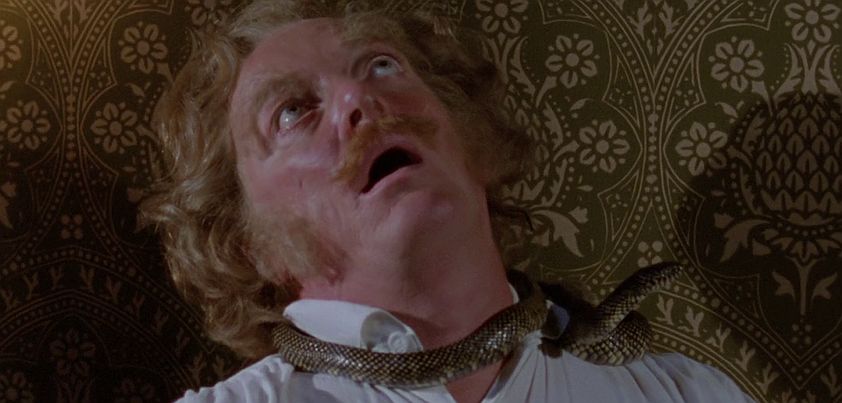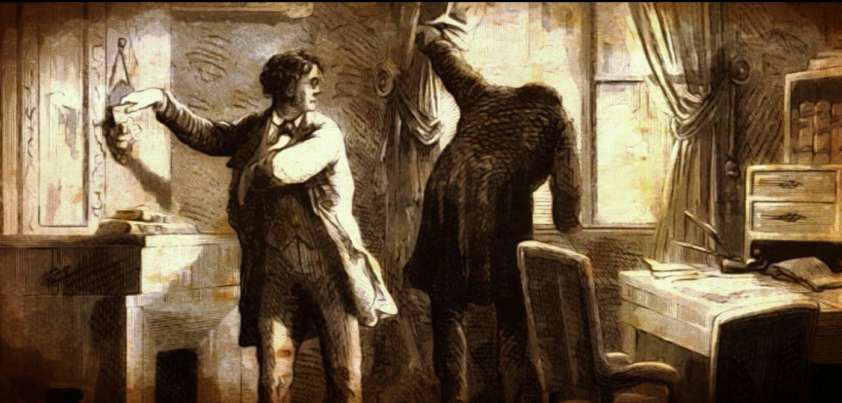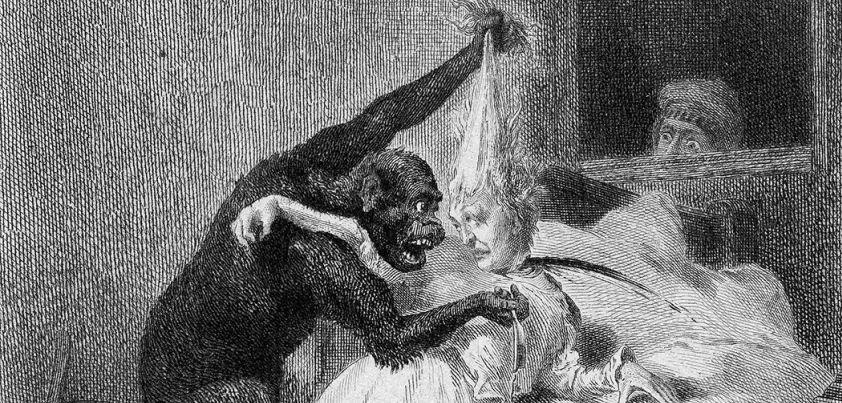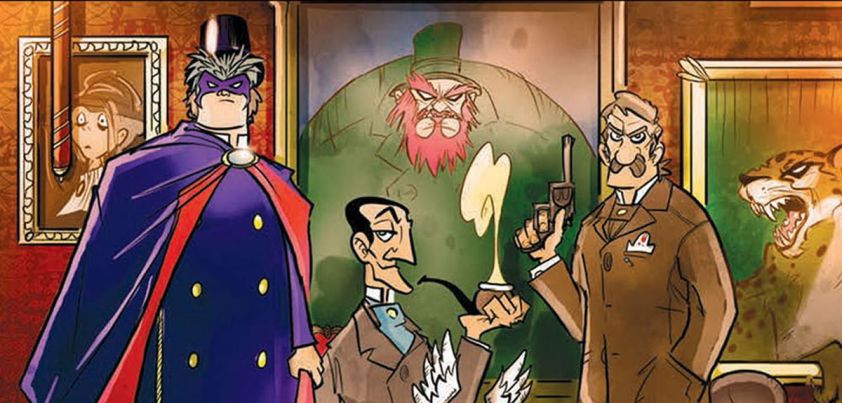 Today we have two stories by Arthur Conan Doyle dealing with the “death” and “rebirth” of Sherlock Holmes. In The Final Problem, Holmes has his first and last encounter with master criminal and his intellectual equal, Professor James Moriarty. After a pursuit across Europe, the pair are believed to have perished when they tumbled off the Reichenbach Falls during a struggle. In the Adventure of the Empty House, Holmes miraculously returns to bring three remaining members of Moriarty’s criminal network to justice. In capturing the first, he solves an important murder investigation. Themes include justice, pursuit, deception, courage, sacrifice, death. More…
Today we have two stories by Arthur Conan Doyle dealing with the “death” and “rebirth” of Sherlock Holmes. In The Final Problem, Holmes has his first and last encounter with master criminal and his intellectual equal, Professor James Moriarty. After a pursuit across Europe, the pair are believed to have perished when they tumbled off the Reichenbach Falls during a struggle. In the Adventure of the Empty House, Holmes miraculously returns to bring three remaining members of Moriarty’s criminal network to justice. In capturing the first, he solves an important murder investigation. Themes include justice, pursuit, deception, courage, sacrifice, death. More…
Archives
The Adventure of the Speckled Band
 This story, considered by Arthur Conan Doyle to be his best Sherlock Holmes mystery, features one of his most creative (and unlikeliest) murder plots. Thirty-year-old Helen, Holmes’s client, is a victim of Victorian attitudes towards women. Fearing for their future, her dead mother had decided that she and twin sister Julia would not receive their inheritances until they married. Their violent stepfather, who manages the money, will become destitute should either of them wed. After announcing her engagement, Julia dies under mysterious circumstances. Helen fears that she will be next. Themes: decay, isolation, fear, murder, class, greed, hasty judgement, justice. More…
This story, considered by Arthur Conan Doyle to be his best Sherlock Holmes mystery, features one of his most creative (and unlikeliest) murder plots. Thirty-year-old Helen, Holmes’s client, is a victim of Victorian attitudes towards women. Fearing for their future, her dead mother had decided that she and twin sister Julia would not receive their inheritances until they married. Their violent stepfather, who manages the money, will become destitute should either of them wed. After announcing her engagement, Julia dies under mysterious circumstances. Helen fears that she will be next. Themes: decay, isolation, fear, murder, class, greed, hasty judgement, justice. More…
The Adventure of the Dancing Men
 In this mystery by Arthur Conan Doyle, an English squire from a highly respected family asks Sherlock Holmes for help. His new bride has been receiving messages written in a strange code that appear to terrify her. The woman, an American, refuses to discuss her past, and a condition of her marrying him was that he must promise never to ask about it. Holmes takes on the case and easily cracks the code, but doesn’t move quickly enough to prevent a murder. Themes include honor, shame, secretiveness, fear, unrequited love, obsession, crime and justice. More…
In this mystery by Arthur Conan Doyle, an English squire from a highly respected family asks Sherlock Holmes for help. His new bride has been receiving messages written in a strange code that appear to terrify her. The woman, an American, refuses to discuss her past, and a condition of her marrying him was that he must promise never to ask about it. Holmes takes on the case and easily cracks the code, but doesn’t move quickly enough to prevent a murder. Themes include honor, shame, secretiveness, fear, unrequited love, obsession, crime and justice. More…
The Purloined Letter
 Edgar Allan Poe is famous for his horror stories. However, only about fifteen of his sixty or so stories are of this kind.He is also widely recognized as the “father” of modern detective fiction thanks to his three tales featuring the Chevalier [Sir] Auguste Dupin. In a manner later emulated by the likes of Sherlock Holmes and Hercule Poirot, Dupin succeeds where eminent policemen fail… in this case, simply by recognizing that the best place to hide something important is in plain sight. Themes: blackmail, political manipulation, deception, linear (scientific) vs. lateral thinking. More…
Edgar Allan Poe is famous for his horror stories. However, only about fifteen of his sixty or so stories are of this kind.He is also widely recognized as the “father” of modern detective fiction thanks to his three tales featuring the Chevalier [Sir] Auguste Dupin. In a manner later emulated by the likes of Sherlock Holmes and Hercule Poirot, Dupin succeeds where eminent policemen fail… in this case, simply by recognizing that the best place to hide something important is in plain sight. Themes: blackmail, political manipulation, deception, linear (scientific) vs. lateral thinking. More…
The Red-Headed League
 A common theme in most detective stories is superior observation skills and deductive reasoning. A defining feature of Arthur Conan Doyle’s Red-Headed League is the way the facts presented by the gullible Wilson appear so bizarre to Watson as to defy interpretation. This prompts Holmes’s to quip: Omne ignotum pro magnifico [we exaggerate the importance of the unknown]. Once he dismisses the Red-Headed League as a distraction, identifying the crime in progress becomes a straightforward matter for the great detective. Other themes include deception (appearance vs. reality), gullibility, greed (of both the criminals and Wilson), crime and justice. More…
A common theme in most detective stories is superior observation skills and deductive reasoning. A defining feature of Arthur Conan Doyle’s Red-Headed League is the way the facts presented by the gullible Wilson appear so bizarre to Watson as to defy interpretation. This prompts Holmes’s to quip: Omne ignotum pro magnifico [we exaggerate the importance of the unknown]. Once he dismisses the Red-Headed League as a distraction, identifying the crime in progress becomes a straightforward matter for the great detective. Other themes include deception (appearance vs. reality), gullibility, greed (of both the criminals and Wilson), crime and justice. More…
The Murders in the Rue Morgue
 Written in 1841, this rather unlikely story by Edgar Allan Poe is considered one of the world’s first modern detective stories. In a seemingly insoluble locked-room mystery, the wrong man is arrested for the violent murder of two women. In an effort to find the truth, Poe’s amateur detective Dupin demonstrates the importance of “mental analysis” in problem solving and, in the process, shows how an “Ourang-Outang” was able to make a monkey out of the police. Themes include ingenuity (inventiveness) vs. mental analysis (critical thinking), violence, the pursuit of truth, justice. More…
Written in 1841, this rather unlikely story by Edgar Allan Poe is considered one of the world’s first modern detective stories. In a seemingly insoluble locked-room mystery, the wrong man is arrested for the violent murder of two women. In an effort to find the truth, Poe’s amateur detective Dupin demonstrates the importance of “mental analysis” in problem solving and, in the process, shows how an “Ourang-Outang” was able to make a monkey out of the police. Themes include ingenuity (inventiveness) vs. mental analysis (critical thinking), violence, the pursuit of truth, justice. More…
A Scandal in Bohemia
 This is the first of Arthur Conan Doyle’s Sherlock Holmes short stories. The hereditary King of Bohemia hires Holmes to retrieve (steal!) photographic evidence of a scandalous affair. Uncharacteristically, the great detective underestimates the jilted woman and is unable to complete the assignment. Rather than displaying frustration or anger, Holmes is smitten… not with love, but with admiration for her intellect. Themes: philandering, class, sexism, deception, underestimating one’s foe, respect. Some say that Holmes’s esteem for Adler suggests a feminist theme. However, as Watson says, she is the woman; the only one he ever regards so highly. More…
This is the first of Arthur Conan Doyle’s Sherlock Holmes short stories. The hereditary King of Bohemia hires Holmes to retrieve (steal!) photographic evidence of a scandalous affair. Uncharacteristically, the great detective underestimates the jilted woman and is unable to complete the assignment. Rather than displaying frustration or anger, Holmes is smitten… not with love, but with admiration for her intellect. Themes: philandering, class, sexism, deception, underestimating one’s foe, respect. Some say that Holmes’s esteem for Adler suggests a feminist theme. However, as Watson says, she is the woman; the only one he ever regards so highly. More…